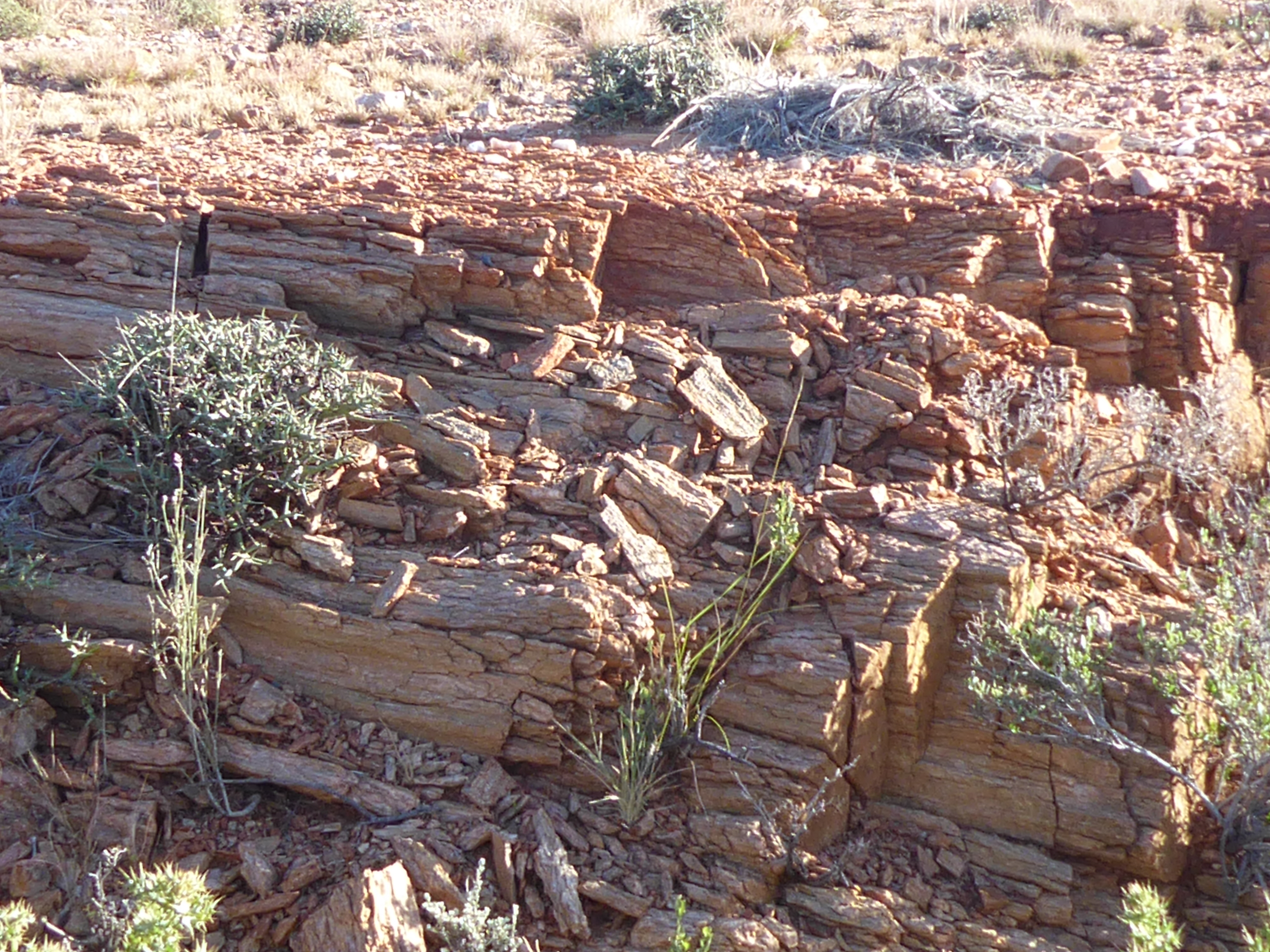Lithops Scrapbook IV
Return to Keith's Home Page
Lithops Scrapbook IV
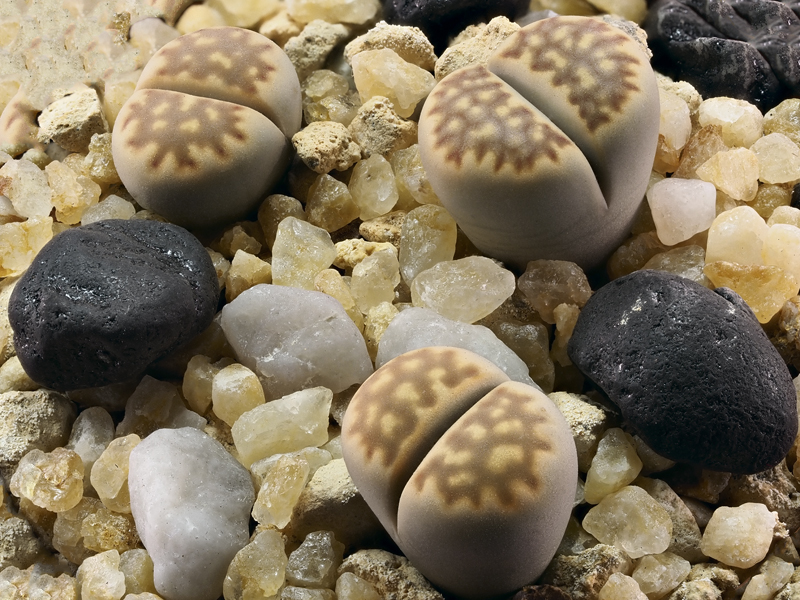
Photograph © Boris Rommer.
Introduction
This is a continuation of the Lithops Scrapbook project, and it exists to prevent Lithops Scrapbook III from becoming over complicated to navigate.
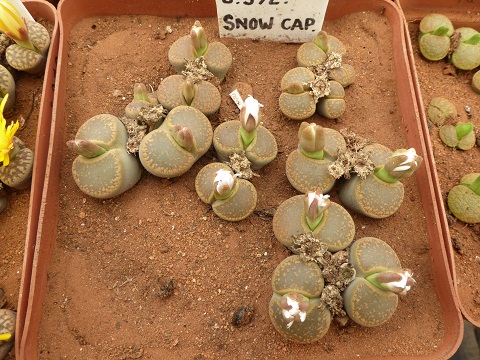
photographed by the author.
White flowers replace the yellow in this classic Ed Storms cultivar from 1979.
Abbreviations
Abbreviations used throughout the text include:-
- ‘acf’ = aberrant colour form
- C = Cole (Lithops colony) number
- ‘Cole’88’ = D.T. COLE, LITHOPS - FLOWERING STONES (1988)
- ‘Cole’05’ = D.T.& N.A. COLE, LITHOPS - FLOWERING STONES (2005)
- “Cole monographs” = both of the above books combined
- G- (type ‘acf’) = "instances of plants which lack their normal pigmentation and have an unusually green or yellow green basic colour" (‘Cole’88’ p. 83), written as “YG” in ‘Cole’88’.
- I.C.B.N. or Botanical Code = International Code of Botanical Nomenclature (this became the “International Code of Nomenclature for algae, fungi and plants” in 2011)
- I.C.N. or Botanical Code = International Code of Nomenclature for algae, fungi and plants (formerly the “International Code of Botanical Nomenclature")
- I.C.N.C.P. or Cultivated Plant Code = International Code of Nomenclature for Cultivated Plants
- L. = Lithops
- M.S.G. = Mesemb. Study Group
- M.S.G. Bulletin = Quarterly publication of the M.S.G.
- R-(type ‘acf’) = “red mutant” (‘Cole’05’ p. 14), simply written as “R” in ‘Cole’88’.
- ‘Shimada (2001)’ = YASUHIKO SHIMADA – THE GENUS LITHOPS (2001)
- S.S.S.A. = Succulent Society of South Africa
- subsp. = subspecies, subspecies
- var. = varietas, variety
- W-(type ‘acf’) = "instances of white flowers in species which are normally yellow flowering" (‘Cole‘88’ p. 83), written as “A” in ‘Cole’88’.
- Y = Lithops species that normally flower yellow
- Y-(type 'acf') = instances of yellow flowers on normally white flowering Lithops (‘Cole’05’ p. 67)
- Ywc = Lithops species that normally flower yellow with a white centre
- * = invalid, unestablished or excluded name, number or status.
Photographic images are reproduced with the permission of the © holders. Text and author photographs © Keith Green.
Lithops Scrapbook IV preamble
Regardless of any commercial scale production, unregulated advertising or proposals to alter names, the original “SCRAPBOOKLITHOPS” focus to simply record correctly classified Lithops at all ranks continues here.
It is worth highlighting Article 2.20 of the I.C.N.C.P. (2016) where it states: “In considering whether two or more plants belong to the same or different cultivars, their origins are irrelevant. Plants that cannot be distinguished from others by any of the means currently adopted for cultivar determination in the group concerned are treated as one cultivar.”
Also worth repeating are a few lines from page 28 of ‘Cole’05’ that state: “The most recent classification is very emphatically NOT necessarily the best, nor the most valid scientifically, nor the most likely to gain general acceptance.”
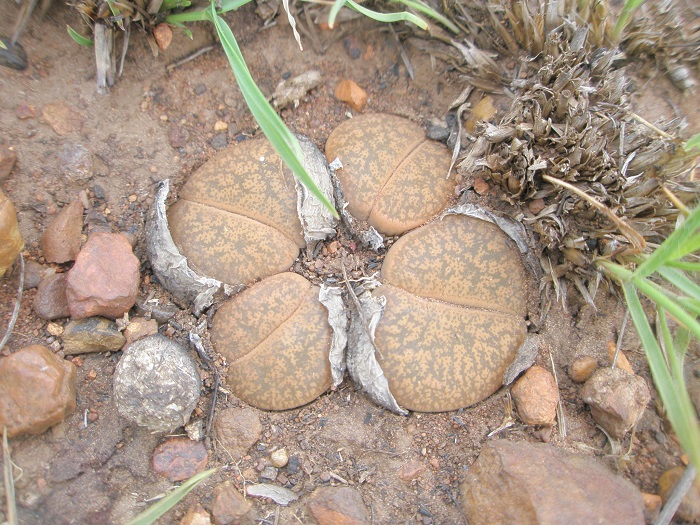
The iconic type species in habitat as photographed by the author.
This image was also published in the journal Dinteranthus vol. 35, p. 28 (2023).
A third point concerns yellow flowers with white centres occurring in species regarded as purely yellow flowered. On page 41 of ‘Cole’ 05’ it states: “The feature appears sporadically also in a number of other Y species, such as L. lesliei, L. aucampiae, L. pseudotruncatella and L. gracilidelineata; it appears very frequently, and is even the norm, in some eastern colonies of L. terricolor”. Conversely, pure yellow flowers occasionally manifest within Ywc species.
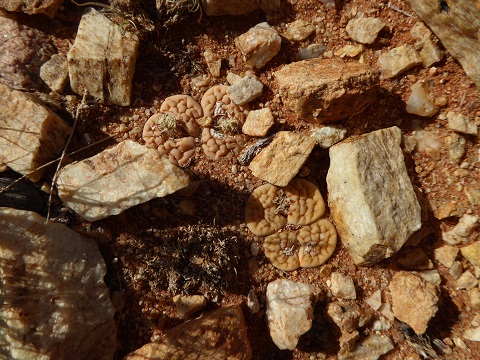
As seen and photographed in habitat by the author.
This image was also published in the journal Dinteranthus vol. 35, p. 31 (2023).
Maintaining Cole principles, the following are Lithops that were validly published in accordance with the I.C.N. (formerly the I.C.B.N.) or established in accordance with the I.C.N.C.P. subsequent to Lithops Scrapbook III.
Lithops Classification
The classification system here remains firmly based on that presented by Cole & Cole in 2005.
Newly introduced Lithops are highlighted here with underlined blue links. Lithops highlighted in brown are noted in Lithops Scrapbook I, Lithops highlighted solely in bold are noted in Lithops Scrapbook II and Lithops highlighted in green are noted in Lithops Scrapbook III. All volumes are viewable from this website. The Lithops written in standard font are the base plants described in the "Cole monographs" and noted in "the basics" section of of this website.The following is a list of all accepted plants within the Lithops genus.
- 'Amethyst'
- amicorum D.T.Cole
- amicorum D.T.Cole ‘Freckled Friend’
- aucampiae L.Bol. subsp. aucampiae var. aucampiae
- aucampiae L.Bol. subsp. aucampiae var. aucampiae 'Betty’s Beryl'
- aucampiae L.Bol. subsp. aucampiae var. aucampiae 'Corona'
- aucampiae L.Bol. subsp. aucampiae var. aucampiae ‘Halo’
- aucampiae L.Bol. subsp. aucampiae var. aucampiae 'Jackson’s Jade'
- aucampiae L.Bol. subsp. aucampiae var. aucampiae ‘Rudesheim Ruby’
- aucampiae L.Bol. subsp. aucampiae var. aucampiae 'Storms's Snowcap'
- aucampiae L.Bol. subsp. aucampiae var. koelemanii (H.W.de Boer) D.T.Cole
- aucampiae L.Bol. subsp. aucampiae var. koelemanii (H.W.de Boer) D.T.Cole 'Charming Mustard'
- aucampiae L.Bol. subsp. euniceae (H.W.deBoer) D.T.Cole var. euniceae
- aucampiae L.Bol. subsp. euniceae (H.W.deBoer) D.T.Cole var. euniceae ‘Bellaketty’
- aucampiae L.Bol. subsp. euniceae (H.W.deBoer) D.T.Cole var. euniceae 'Hikoruby'
- aucampiae L.Bol. subsp. euniceae (H.W.deBoer) D.T.Cole var. euniceae 'Red Brownie'
- aucampiae L.Bol. subsp. euniceae (H.W.deBoer) D.T.Cole var. fluminalis D.T.Cole
- aucampiae L.Bol. subsp. euniceae (H.W.deBoer) D.T.Cole var. fluminalis D.T.Cole 'Chieruby'
- aucampiae L.Bol. subsp. euniceae (H.W.deBoer) D.T.Cole var. fluminalis D.T.Cole ‘Gariep Juweel’
- aucampiae L.Bol. subsp. euniceae (H.W.deBoer) D.T.Cole var. fluminalis D.T.Cole 'Mado-Chieruby'
- aucampiae L.Bol. subsp. euniceae (H.W.deBoer) D.T.Cole var. fluminalis D.T.Cole 'Mado-Yogetugyoku'
- aucampiae L.Bol. subsp. euniceae (H.W.deBoer) D.T.Cole var. fluminalis D.T.Cole ‘Spotted Dog’
- bromfieldii L.Bol. var. bromfieldii
- bromfieldii L.Bol. var. bromfieldii ‘Noemie's Kiwi’
- bromfieldii L.Bol. var. bromfieldii ‘White Nymph’
- bromfieldii L.Bol. var. glaudinae (H.W.deBoer) D.T.Cole
- bromfieldii L.Bol. var. glaudinae (H.W.deBoer) D.T.Cole ‘Embers’
- bromfieldii L.Bol. var. glaudinae (H.W.deBoer) D.T.Cole 'Strawberry Jam'
- bromfieldii L.Bol. var. insularis (L.Bol.) B.Fearn
- bromfieldii L.Bol. var. insularis (L.Bol.) B.Fearn 'Sulphurea'
- bromfieldii L.Bol. var. mennellii (L.Bol.) B.Fearn
- bromfieldii L.Bol. var. mennellii B.Fearn 'Shinano Gold Moon'
- bromfieldii L.Bol. 'Desert River'
- bromfieldii L.Bol.‘Red Coral’
- ‘Chinchillas ZW’
- coleorum S.A.Hammer & Uijs
- coleorum S.A.Hammer & R.R.J.Uijs 'Peridot'
- coleorum S.A.Hammer & Uijs ‘Lindsey Deaves’
- comptonii L.Bol. var. comptonii
- comptonii L.Bol. var. weberi (Nel) D.T.Cole
- dinteri Schwant. subsp. dinteri var. dinteri
- dinteri Schwant. subsp. dinteri var. dinteri 'Dintergreen'
- dinteri Schwant. subsp. dinteri var. brevis (L.Bol.) B.Fearn
- dinteri Schwant. subsp. frederici (D.T.Cole) D.T.Cole
- dinteri Schwant. subsp. multipunctata (H.W.de Boer) D.T.Cole
- divergens L.Bol. var. divergens
- divergens L.Bol. var. divergens ‘Pearl Blush’
- divergens L.Bol. var. amethystina H.W.deBoer
- divergens L.Bol. var. amethystina H.W.deBoer 'Sunny Grassland ZW'
- dorotheae Nel
- dorotheae Nel 'Akahada Reikogyoku'
- dorotheae Nel 'Kihada Reikogyoku'
- dorotheae Nel 'Red Phoenix'
- dorotheae Nel 'Zorro'
- francisci Dint. & Schwant.
- fulviceps (N.E.Br.) N.E.Br. var. fulviceps
- fulviceps (N.E.Br.) N.E.Br. var. fulviceps 'Aurea'
- fulviceps (N.E.Br.) N.E.Br. var. lactinea D.T.Cole
- fulviceps (N.E.Br.) N.E.Br. var. laevigata D.T.Cole
- gesinae H.W.de Boer var. gesinae
- gesinae H.W.de Boer var. annae (H.W.deBoer) D.T.Cole
- gesinae H.W.de Boer var. annae (H.W.deBoer) D.T.Cole ‘Hanawared’
- geyeri Nel
- geyeri Nel 'White Silk'
- gracilidelineata Dint. subsp. gracilidelineata var. gracilidelineata
- gracilidelineata Dint. subsp. gracilidelineata var. gracilidelineata 'Café au lait'
- gracilidelineata Dint. subsp. gracilidelineata var. gracilidelineata 'Ernst's Witkop'
- gracilidelineata Dint. subsp. gracilidelineata var. gracilidelineata 'Matcha Latte SY'
- gracilidelineata Dint. subsp. gracilidelineata var. gracilidelineata 'Paw Pads'
- gracilidelineata Dint. subsp. gracilidelineata var. gracilidelineata 'Snow Fog'
- gracilidelineata Dint. subsp. gracilidelineata var. gracilidelineata 'Vein'
- gracilidelineata Dint. subsp. gracilidelineata var. waldroniae H.W.de Boer
- gracilidelineata Dint. subsp. gracilidelineata var. waldroniae H.W.deBoer 'Federvogel Green'
- gracilidelineata Dint. subsp. gracilidelineata var. waldroniae H.W.de Boer 'Fritz's White Lady'
- gracilidelineata Dint. subsp. brandbergensis (H.W.de Boer) D.T.Cole
- gracilidelineata Dint. subsp. brandbergensis (H.W.de Boer) D.T.Cole‘Vertigo’
- gracilidelineata Dint. subsp. brandbergensis (H.W.de Boer) D.T.Cole 'Vertivein'
- gracilidelineata Dint. 'Brandcafé'
- 'Grain Rain ZW'
- 'Green Kiku'
- hallii H.W.de Boer var. hallii
- hallii H.W.de Boer var. hallii 'Black Spiderweb'
- hallii H.W.de Boer var. hallii 'Sakkie's Green'
- hallii H.W.de Boer var. ochracea (H.W.de Boer) D.T.Cole
- hallii H.W.de Boer var. ochracea (H.W.de Boer) D.T.Cole 'Green Soapstone'
- ‘Harlequin’
- 'Hejian'
- helmutii L.Bol.
- hermetica D.T.Cole
- hermetica D.T.Cole ‘Green Diamond’
- herrei L.Bol.
- herrei L.Bol. 'Splendido'
- hookeri (Berg.) Schwant. var. hookeri
- hookeri (Berg.) Schwant. var. hookeri 'Envy'
- hookeri (Berg.) Schwant. var. dabneri (L.Bol.) D.T.Cole
- hookeri (Berg.) Schwant. var. dabneri (L.Bol.) D.T.Cole ‘Annarosa’
- hookeri (Berg.) Schwant. var. dabneri (L.Bol.) D.T.Cole 'Olive Rose'
- hookeri (Berg.) Schwant. var. elephina (D.T.Cole) D.T.Cole
- hookeri (Berg.) Schwant. var. lutea (H.W.de Boer) D.T.Cole
- hookeri (Berg.) Schwant. var. lutea (H.W.de Boer) D.T.Cole 'Aubarede'
- hookeri (Berg.) Schwant. var. marginata (Nel) D.T.Cole
- hookeri (Berg.) Schwant. var. marginata (Nel) D.T.Cole 'Shimada's Apricot'
- hookeri (Berg.) Schwant. var. subfenestrata (H.W.de Boer) D.T.Cole
- hookeri (Berg.) Schwant. var. susannae (D.T.Cole) D.T.Cole
- hookeri (Berg.) Schwant. var. susannae (D.T.Cole) D.T.Cole 'White Susan'
- hookeri (Berg.) Schwant. 'Red Planet'
- julii (Dint. & Schwant.) N.E.Br. subsp. julii
- julii (Dint. & Schwant.) N.E.Br. subsp. julii ‘Chatora’
- julii (Dint. & Schwant.) N.E.Br. subsp. julii ‘Honey Lips ZW’
- julii (Dint. & Schwant.) N.E.Br. subsp. julii 'Hotlips'
- julii (Dint. & Schwant.) N.E.Br. subsp. julii 'Peppermint Creme'
- julii (Dint. & Schwant.) N.E.Br. subsp. julii ‘Red Reticulata’
- julii (Dint. & Schwant.) N.E.Br. subsp. julii ‘Yukari’
- julii (Dint. & Schwant.) N.E.Br. subsp. julii 'Yunmeng Lake ZW'
- julii (Dint. & Schwant.) N.E.Br. subsp. fulleri (N.E.Br.) B.Fearn var. fulleri
- julii (Dint. & Schwant.) N.E.Br. subsp. fulleri (N.E.Br.) B.Fearn var. fulleri 'Fullergreen'
- julii (Dint. & Schwant.) N.E.Br. subsp. fulleri (N.E.Br.) B.Fearn var. fulleri 'Fuyu Mountain SY'
- julii (Dint. & Schwant.) N.E.Br. subsp. fulleri (N.E.Br.) B.Fearn var. fulleri ‘Limelight’
- julii (Dint. & Schwant.) N.E.Br. subsp. fulleri (N.E.Br.) B.Fearn var. brunnea H.W.de Boer
- julii (Dint. & Schwant.) N.E.Br. subsp. fulleri (N.E.Br.) B.Fearn var. rouxii (H.W.de Boer) D.T.Cole
- julii (Dint. & Schwant.) N.E.Br. subsp. fulleri (N.E.Br.) B.Fearn var. rouxii (H.W.de Boer) D.T.Cole 'Green Stitch'
- julii (Dint. & Schwant.) N.E.Br. 'Morning Fog'
- julii (Dint. & Schwant.) N.E.Br. ‘Nine Rivers ZW’
- julii (Dint. & Schwant.) N.E.Br. subsp. fulleri (N.E.Br.) B.Fearn 'Lugu Lake'
- karasmontana (Dint. & Schwant.) N.E.Br. subsp. karasmontana var. karasmontana
- karasmontana (Dint. & Schwant.) N.E.Br. subsp. karasmontana var. karasmontana '50 Shades of Gray'
- karasmontana (Dint. & Schwant.) N.E.Br. subsp. karasmontana var. karasmontana 'Cookie'
- karasmontana (Dint. & Schwant.) N.E.Br. subsp. karasmontana var. karasmontana 'De Boer's Mick'
- karasmontana (Dint. & Schwant.) N.E.Br. subsp. karasmontana var. karasmontana 'Karasbijin'
- karasmontana (Dint. & Schwant.) N.E.Br. subsp. karasmontana var. karasmontana ‘Rosary’
- karasmontana (Dint. & Schwant.) N.E.Br. subsp. karasmontana var. karasmontana ‘Lateritia’
- karasmontana (Dint. & Schwant.) N.E.Br. subsp. karasmontana var. karasmontana ‘Opalina’
- karasmontana (Dint. & Schwant.) N.E.Br. subsp. karasmontana var. karasmontana ‘Top Red’
- karasmontana (Dint. & Schwant.) N.E.Br. subsp. karasmontana var. aiaisensis (H.W.de Boer) D.T.Cole
- karasmontana (Dint. & Schwant.) N.E.Br. subsp. karasmontana var. aiaisensis (H.W.de Boer) D.T.Cole ‘Orange Ice’
- karasmontana (Dint. & Schwant.) N.E.Br. subsp. karasmontana var. immaculata D.T.Cole
- karasmontana (Dint. & Schwant.) N.E.Br. subsp. karasmontana var. lericheana (Dint. &Schwant.) D.T.Cole
- karasmontana (Dint. & Schwant.) N.E.Br. subsp. karasmontana var. lericheana (Dint. &Schwant.) D.T.Cole 'Lerichegreen’
- karasmontana (Dint. & Schwant.) N.E.Br. subsp. karasmontana var. lericheana (Dint. & Schwant.) D.T.Cole 'Mado-Shugengyoku'
- karasmontana (Dint. & Schwant.) N.E.Br. subsp. karasmontana var. tischeri D.T.Cole
- karasmontana (Dint. & Schwant.) N.E.Br. subsp. bella (N.E.Br.) D.T.Cole
- karasmontana (Dint. & Schwant.) N.E.Br. subsp. bella (N.E.Br.) D.T.Cole 'Cascade'
- karasmontana (Dint. & Schwant.) N.E.Br. subsp. bella (N.E.Br.) D.T.Cole 'Ironstone'
- karasmontana (Dint. & Schwant.) N.E.Br. subsp. eberlanzii (Dint. & Schwant.) D.T.Cole
- karasmontana (Dint. & Schwant.) N.E.Br. subsp. eberlanzii (Dint. & Schwant.) D.T.Cole 'Avocado Cream'
- karasmontana (Dint. & Schwant.) N.E.Br. subsp. eberlanzii (Dint. & Schwant.) D.T.Cole 'Mirage'
- karasmontana (Dint. & Schwant.) N.E.Br. subsp. eberlanzii (Dint. & Schwant.) D.T.Cole ‘Purper’
- karasmontana (Dint. & Schwant.) N.E.Br. 'Axel's Rose'
- karasmontana (Dint. & Schwant.) N.E.Br. 'Suiren'
- ‘Kikukaseki’
- ‘Kikushogyoku’
- ‘Kosogyoku’
- ‘Lava Flow’
- lesliei (N.E.Br.) N.E.Br. subsp. lesliei var. lesliei
- lesliei (N.E.Br.) N.E.Br. subsp. lesliei var. lesliei 'Albiflora'
- lesliei (N.E.Br.) N.E.Br. subsp. lesliei var. lesliei 'Albinica'
- lesliei (N.E.Br.) N.E.Br. subsp. lesliei var. lesliei 'Cherry'
- lesliei (N.E.Br.) N.E.Br. subsp. lesliei var. lesliei ‘Fred’s Redhead’
- lesliei (N.E.Br.) N.E.Br. subsp. lesliei var. lesliei 'Green Top'
- lesliei (N.E.Br.) N.E.Br. subsp. lesliei var. lesliei 'Hanabi'
- lesliei (N.E.Br.) N.E.Br. subsp. lesliei var. lesliei 'Pietersgreen'
- lesliei (N.E.Br.) N.E.Br. subsp. lesliei var. lesliei 'Pietersruby'
- lesliei (N.E.Br.) N.E.Br. subsp. lesliei var. lesliei 'Storm's Albinigold'
- lesliei (N.E.Br.) N.E.Br. subsp. lesliei var hornii H.W.de Boer
- lesliei (N.E.Br.) N.E.Br. subsp. lesliei var. hornii H.W.de Boer 'Greenhorn'
- lesliei (N.E.Br.) N.E.Br. subsp. lesliei var. mariae D.T.Cole
- lesliei (N.E.Br.) N.E.Br. subsp. lesliei var. mariae D.T.Cole 'Mariagreen'
- lesliei (N.E.Br.) N.E.Br. subsp. lesliei var. minor H.W.de Boer
- lesliei (N.E.Br.) N.E.Br. subsp. lesliei var. minor H.W.de Boer 'Witblom'
- lesliei (N.E.Br.) N.E.Br. subsp. lesliei var. rubrobrunnea H.W.de Boer
- lesliei (N.E.Br.) N.E.Br. subsp. lesliei var. venteri (Nel) H.W.de Boer & B.K.Boom
- lesliei (N.E.Br.) N.E.Br. subsp. lesliei var. venteri (Nel) H.W.de Boer & B.K.Boom ‘Black Top’
- lesliei (N.E.Br.) N.E.Br. subsp. lesliei var. venteri (Nel) H.W.de Boer & B.K.Boom ‘Citrina’
- lesliei (N.E.Br.) N.E.Br. subsp. lesliei var. venteri (Nel) H.W.de Boer & B.K.Boom ‘Pepper Pot’
- lesliei (N.E.Br.) N.E.Br. subsp. lesliei var. venteri (Nel) H.W.de Boer & B.K.Boom ‘Ventergreen’
- lesliei (N.E.Br.) N.E.Br. subsp. lesliei 'Bronzino'
- lesliei (N.E.Br.) N.E.Br. subsp. lesliei 'Fred's Redhorn'
- lesliei (N.E.Br.) N.E.Br. subsp. burchellii D.T.Cole
- lesliei (N.E.Br.) N.E.Br. subsp. lesliei ‘South Lake ZW’
- lesliei (N.E.Br.) N.E.Br. ‘Sage Sun’s Hairs -ZW-’
- marmorata (N.E.Br.) N.E.Br. var. marmorata
- marmorata (N.E.Br.) N.E.Br. var. marmorata 'Geel Blom'
- marmorata (N.E.Br.) N.E.Br. var. marmorata 'Golden Mane'
- marmorata (N.E.Br.) N.E.Br. var. marmorata 'Polepsky Smaragd'
- marmorata (N.E.Br.) N.E.Br. var. elisae (H.W.de Boer) D.T.Cole
- meyeri L.Bol.
- meyeri L.Bol. 'Hammeruby'
- ‘Moss Agate’
- 'Murasaki-Kikukaeski’
- 'Murasaki-Kikushogyoku’
- naureeniae D.T.Cole
- naureeniae D.T.Cole 'Pinkies'
- naureeniae D.T.Cole 'Hulun Buir'
- ‘Nuwa Stone ZW’
- olivacea L.Bol. var. olivacea
- olivacea L.Bol. var. olivacea ‘Angel's of Tony’
- olivacea L.Bol. var. olivacea D.T.Cole 'Voldemort's Visage'
- olivacea L.Bol. var. nebrownii D.T.Cole
- olivacea L.Bol. var. nebrownii D.T.Cole 'Red Olive'
- optica (Marl.) N.E.Br.
- optica (Marl.) N.E.Br. 'Opticagold'
- optica (Marl.) N.E.Br. 'Rubra'
- optica (Marl.) N.E.Br. ‘Rubragold’
- optica (Marl.) N.E.Br. 'Rubra Henge'
- optica (Marl.) N.E.Br. ‘Ruby’
- otzeniana Nel
- otzeniana Nel 'Aquamarine'
- otzeniana Nel 'Cesky Granat'
- otzeniana Nel. 'Frik Green'
- otzeniana Nel. 'Frik Grey'
- otzeniana Nel. 'Midori-Otsue'
- otzeniana Nel. 'Yamato Granat'
- pseudotruncatella (Berg.) N.E.Br. subsp. pseudotruncatella var. pseudotruncatella
- pseudotruncatella (Berg.) N.E.Br. subsp. pseudotruncatella var. pseudotruncatella 'Albiflora'
- pseudotruncatella (Berg.) N.E.Br. subsp. pseudotruncatella var. pseudotruncatella 'Matchless Green'
- pseudotruncatella (Berg.) N.E.Br. subsp. pseudotruncatella var. pseudotruncatella ‘Springbloom’
- pseudotruncatella (Berg.) N.E.Br. subsp. pseudotruncatella var. elisabethiae (Dint.) H.W.deBoer &B.K. Boom
- pseudotruncatella (Berg.) N.E.Br. subsp. pseudotruncatella var. elisabethiae (Dint.) H.W.de Boer & B.K. Boom ‘White Queen’
- pseudotruncatella (Berg.) N.E.Br. subsp. pseudotruncatella var. riehmerae D.T.Cole
- pseudotruncatella (Berg.) N.E.Br. subsp. pseudotruncatella var. riehmerae D.T.Cole ‘Green Ivory’
- pseudotruncatella (Berg.) N.E.Br. subsp. archerae (H.W.de Boer) D.T.Cole
- pseudotruncatella (Berg.) N.E.Br. subsp. archerae (H.W.de Boer) D.T.Cole 'Kegon'
- pseudotruncatella (Berg.) N.E.Br. subsp. archerae (H.W.de Boer) D.T.Cole 'Split Pea'
- pseudotruncatella (Berg.) N.E.Br. subsp. dendritica (Nel) D.T.Cole
- pseudotruncatella (Berg.) N.E.Br. subsp. dendritica (Nel) D.T.Cole 'Tok's Rock'
- pseudotruncatella (Berg.) N.E.Br. subsp. groendrayensis (Jacobs.) D.T.Cole
- pseudotruncatella (Berg.) N.E.Br. subsp. schoemanii R.A.Earlẻ & R.R.J.Uijs
- pseudotruncatella (Berg.) N.E.Br. subsp. volkii (Schwant. ex H.W.de Boer & B.K.Boom) D.T.Cole
- ruschiorum (Dint. & Schwant.) N.E.Br. var. ruschiorum
- ruschiorum (Dint. & Schwant.) N.E.Br. var. ruschiorum ‘Silver Reed’
- ruschiorum (Dint. & Schwant.) N.E.Br. var. lineata (Nel) D.T.Cole
- salicola L.Bol.
- salicola L.Bol. ‘Daikangyoku’
- salicola L.Bol. 'Malachite'
- salicola L.Bol. 'Sato’s Violet'
- schwantesii Dint. subsp. schwantesii var. schwantesii
- schwantesii Dint. subsp. schwantesii var. schwantesii 'Purple Haze'
- schwantesii Dint. subsp. schwantesii var. marthae (Loesch & Dint.) D.T.Cole
- schwantesii Dint. subsp. schwantesii var. marthae (Loesch & Dint.) D.T.Cole 'Torra Red'
- schwantesii Dint. subsp. schwantesii var. rugosa (Dint.) H.W.de Boer & B.K.Boom
- schwantesii Dint. subsp. schwantesii var. rugosa (Dint.) H.W.de Boer & B.K.Boom 'Blue Moon'
- schwantesii Dint. subsp. schwantesii var. rugosa (Dint.) H.W.de Boer & B.K.Boom 'Shagreen'
- schwantesii Dint. subsp. schwantesii var. urikosensis (Dint.) H.W.de Boer & B.K.Boom
- schwantesii Dint. subsp. schwantesii var. urikosensis (Dint.) H.W.de Boer & B.K.Boom 'Bethanien Green’
- schwantesii Dint. subsp. schwantesii var. urikosensis (Dint.) H.W.de Boer & B.K.Boom 'Nutwerk'
- schwantesii Dint. subsp. schwantesii var. urikosensis (Dint.) H.W.de Boer & B.K.Boom 'Witspook'
- schwantesii Dint. subsp. gebseri (H.W.deBoer) D.T.Cole
- ‘Silwersalm’
- steineckeana Tisch.
- ‘Sunflowers ZW’
- ‘Sunstone’
- ‘Talisman’
- terricolor N.E.Br.
- terricolor N.E.Br. ‘Chocolate Sprinkles’
- terricolor N.E.Br. ‘Green Sandpoort’
- terricolor N.E.Br. ‘Pinky’
- terricolor N.E.Br. 'Silver Spurs'
- terricolor N.E.Br. 'Speckled Gold'
- terricolor N.E.Br. 'Steamy Windows'
- terricolor N.E.Br. 'Violetta'
- vallis-mariae (Dint. & Schwant.) N.E.Br.
- vallis-mariae (Dint. & Schwant.) N.E.Br. 'Orange Peel'
- vallis-mariae (Dint. & Schwant.) N.E.Br. ‘Valley Girl'
- verruculosa Nel var. verruculosa
- verruculosa Nel var. verruculosa 'Chrysoberyl'
- verruculosa Nel var. verruculosa 'Fireworks -ZW-'
- verruculosa Nel var. verruculosa 'Rose of Texas'
- verruculosa Nel var. verruculosa 'Sandstorm'
- verruculosa Nel var. verruculosa 'Verdigris'
- verruculosa Nel var. glabra H.W.deBoer
- verruculosa Nel var. glabra H.W.deBoer 'Scarlet'
- villetii L.Bol. subsp. villetii
- villetii L.Bol. subsp. deboeri (Schwant.) D.T.Cole
- villetii L.Bol. subsp. deboeri (Schwant.) D.T.Cole 'Orihime'
- villetii L Bol. subsp. kennedyi (H.W.deBoer) D.T.Cole
- viridis H.Luckh.
- werneri Schwant. & Jacobs.
- werneri Schwant. & Jacobs. 'Camel'
- 'White Rabbit'
- xhybrida
Key to authors
Berg. = Berger, Alwyn; H.W.de Boer = de Boer, Hindrik Wijbrand; L.Bol. = Bolus, Harriet Margaret Louisa; B.K.Boom = Boom, Boudewijn Karel; N.E.Br. = Brown, Nicholas Edward; D.T.Cole = Cole, Desmond Thorne; Dint. = Dinter, Moriz Kurt; R.A.Earlẻ = Earlẻ, Roy Anthony; B.Fearn = Fearn, Brian; S.A.Hammer = Hammer, Steven Allen; Jacobs. = Jacobsen, Hermann Johannes; Loesch = Loesch, Alfred; H.Luckh. = Luckhoff, Hilmar Albert; Marl. = Marloth, Hermann Wilhelm Rudolf; Nel = Nel, Gert Cornelius; Schwant. = Schwantes, Martin Heinrich Gustav; Tisch. = Tischer, Arthur; Uijs & R.R.J.Uijs = Uijs, Ronald Rousseau Jan.
Lithops N.E.Br. aucampiae L.Bol. subsp. euniceae (H.W.deBoer) D.T.Cole var. euniceae ‘Red Brownie’. (cultivar)
Lithops aucampiae subsp. euniceae var. euniceae ‘Red Brownie’. First published by Kim JaeWoon in “A Cup Cake Cultivar, Mesemb Study Group Bulletin 38(3): 59-60. (December) 2023”. Image example: 2 photographs of plants accompanying the protologue, taken by Kim JaeWoon of Yanju, South Korea. A cultivar with wide open, brownish-orange windows and contrasting light peninsulas.
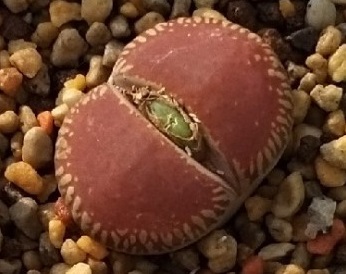
X3 photographs © Kim JaeWoon.
This is a pattern-bred cultivar with wide-open, brownish-orange windows and contrasting light peninsular markings. Whilst a few habitat plants present with open windows too, the facial colour and contrasting margins of ‘Red Brownie’ stand out. Establishment was by Kim JaeWoon in the M.S.G. Bulletin vol. 38, pp. 59-60 (2023), where the approval of the late Terry Smale was also mentioned. The flower colour is the normal yellow of the subspecies and the epithet refers to both the “chocolate-orange cup-cake” appearance of the plants, and the natural red-brown of var. euniceae. The brownish-orange colour is the most obvious distinction between ‘Red Brownie’ and open windowed forms of ‘Hikoruby’, which are redder in tone.
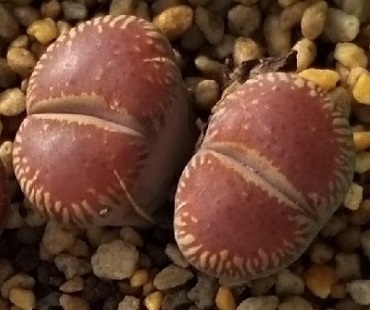
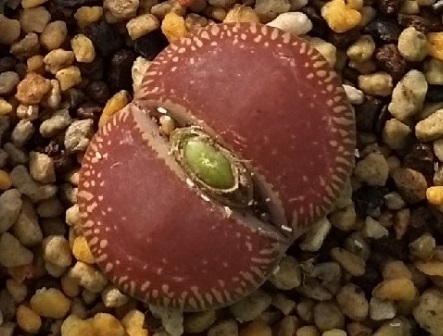
Lithops N.E.Br. coleorum S.A.Hammer & R.R.J.Uijs ‘Peridot’. (cultivar)
Lithops coleorum ‘Peridot’. First published by Keith Green in “That One’s Green, Mesemb Study Group Bulletin 39(1): 2. (July) 2024”. Image example: 3 photographs accompanying the protologue, figures 39.1, 39.2 & 39.3 on page 3 taken by Clive Green of New Malden, England and Bernd Schlösser of Germany. A green bodied cultivar with normal yellow flowers.
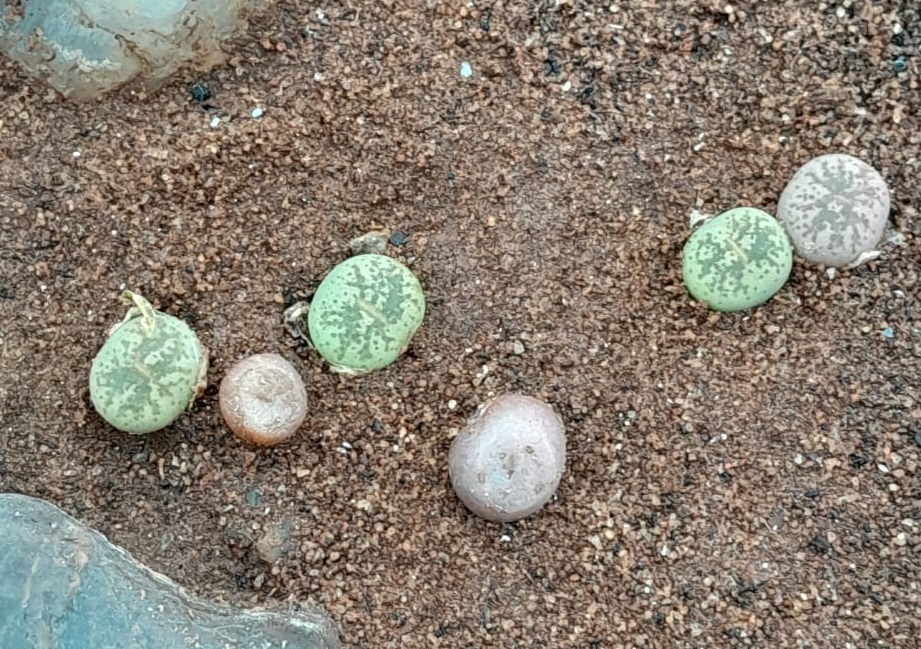
photograph © Will du Toit.
This is a green bodied or G- (type ‘acf’) with normal yellow flowers. It arose through selective breeding after a “greenish” plant grown from M.S.G. 716 seed was first spotted in the collection of Kevin Mason of Carmarthen, Wales in 2000. Subsequent pollination by Keith Green with a pale brown L. coleorum grown from seed numbered S.S.S.A. 263 kick started the selection process. Plants and seed passed through the hands of Bernd Schlösser and Uwe Beyer of Germany and Will du Toit of South Africa before eventually being established by Keith Green in the M.S.G. Bulletin vol. 39, p. 2 (2024). As explained in the publication article: “The normal size and facial patterns of L. coleorum remain, but here are coloured light and dark green, giving an overall bright, but mainly matt appearance.”
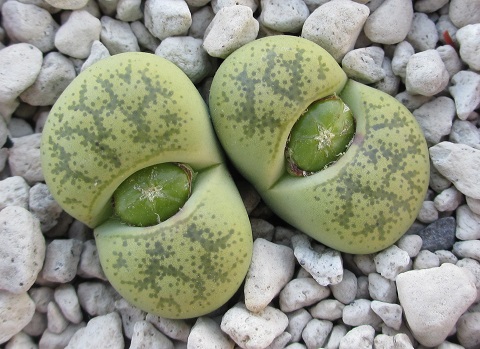
photograph © Bernd Schlosser.

photograph © Clive Green.
Lithops N.E.Br. gracilidelineata Dint. subsp. gracilidelineata var. gracilidelineata ‘Matcha Latte SY’.
Lithops gracilidelineata subsp. gracilidelineata var. gracilidelineata ‘Matcha Latte SY’.. A greenish-brown bodied cultivar with off-white facial patches. Publication pending.
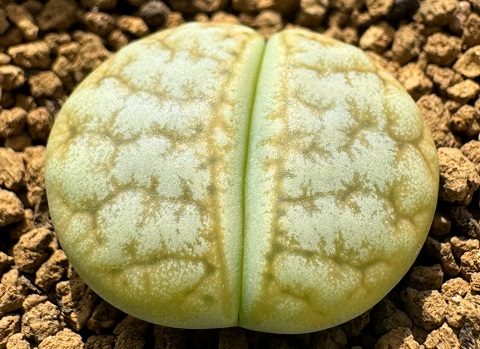
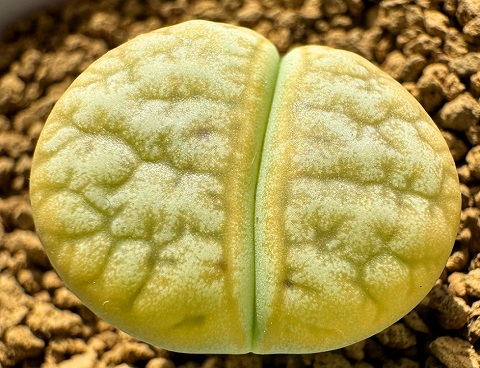
X3 photographs © Shi Yu.
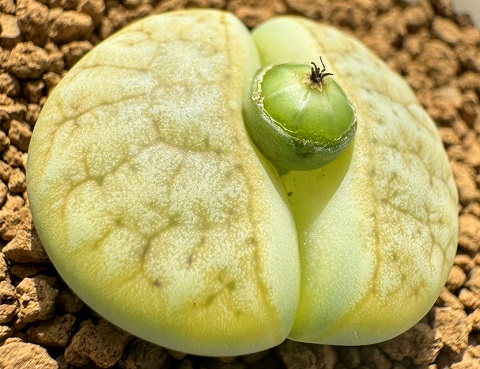
Lithops N.E.Br. gracilidelineata Dint. subsp. gracilidelineata var. waldroniae H.W.deBoer ‘Federvogel Green’. (cultivar)
Lithops gracilidelineata subsp. gracilidelineata var. waldroniae ‘Federvogel Green’. First published Hilde & Frikkie Mouton in “’Federvogel Green’ A new Lithops Cultivar’, Mesemb Study Group Bulletin 38(4): 88. (April) 2024” (issue 4 of 2023). Image example: 3 photographs of plants accompanying the protologue, Figs 38.87–38.89 on page 89, taken by Hilde & Frikkie Mouton of Namibia & Kim JaeWoon of South Korea. A green bodied cultivar of var. waldroniae with normal yellow flowers.
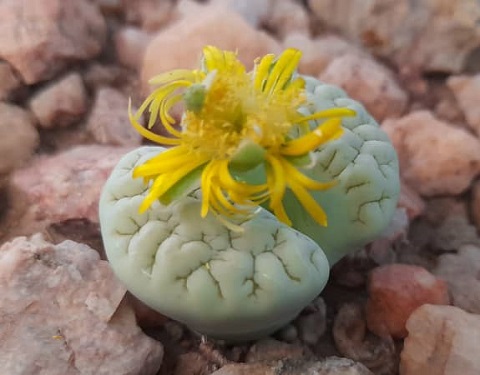
This is a green bodied var. waldroniae with normal yellow flowers that arose in the collection of the late Tok Schoeman of Windhoek and was brought to fruition by Hilde & Frikkie Mouton at the Alte Kalköfen Lodge in Southern Namibia. Plants were established by Hilde & Frikkie in the M.S.G. Bulletin vol. 38, p. 88 (2024), where the name was explained as being the transposed title of a rock formation close to the C189 locality, from where the seed is thought to have originated. Seed subsequently sent to South Korea was successfully raised by Kim JaeWoon.
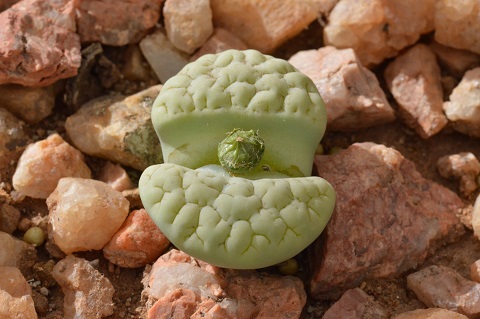
X2 photographs © Hilde & Frikkie Mouton.
Lithops N.E.Br. ‘Green Kiku’. (hybrid)
Lithops ‘Green Kiku’. First published by Keith Green in “Lithops ‘Green Kiku’, Mesemb Study Group Bulletin 40(1): 17. (February) 2025”, but of unknown origin. Image Example: 2 photographs accompanying the protologue, taken by Andy Yang of Yuxi City, China & Keith Green of the UK. A green bodied hybrid with features, sometimes blended, of L. ’Kikukaseki’ & L. ‘Kikushogyoku’.
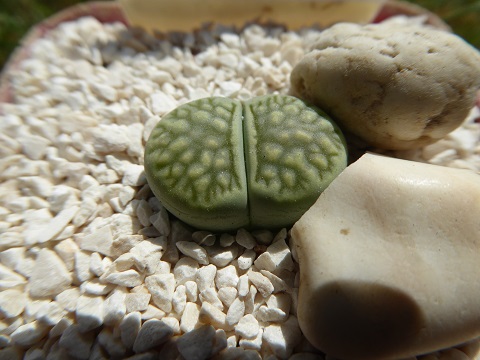
photographed by the author.
Without a formal title, green bodied forms of the L. ‘Kikukaseki’ and L. ‘Kikushogyoku’ hybrids have long been grown in the Far East. Plants can either manifest the typical facial patterns of both the afore mentioned hybrids, or display intermediate features. It seems this same hybrid has been produced independently by many growers, with the “G-type (‘acf’)” cultivars ‘Fullergreen’, ‘Green Soapstone’ and perhaps others playing a part in the formula. Whilst the first or exact origin is lost to time, in the realm of cultivars those that look the same are the same. In order to maintain the status quo, the epithet ‘Green Kiku’ was maintained by Keith Green when photographs of plants raised by Andy Yang were published in the M.S.G. Bulletin, vol 40, p. 17 (2025). These attractive hybrids retain the white flowers of their normal coloured brethren.
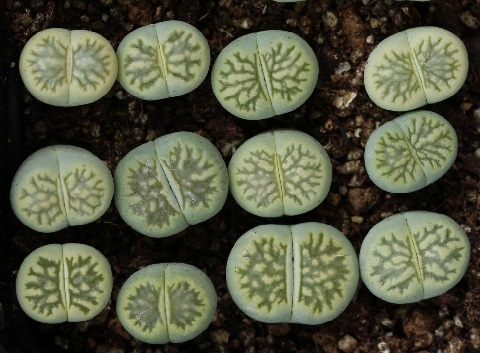
photograph © Andy Yang.
Lithops N.E.Br. ‘Hejian’. (hybrid)
Lithops ‘Hejian’. First published by Zhao Wenya in “Lithops ‘Hejian’, Mesemb Study Group Bulletin 39(1): 2. (July) 2024”. Image example: 3 photographs of plants accompanying the protologue, figures 39.4, 39.5 & 39.6 on page 3 taken by Zhao Wenya of China. A cordate, hybrid cultivar involving L. werneri, with branching orange-brown lines on a rounded pale face.
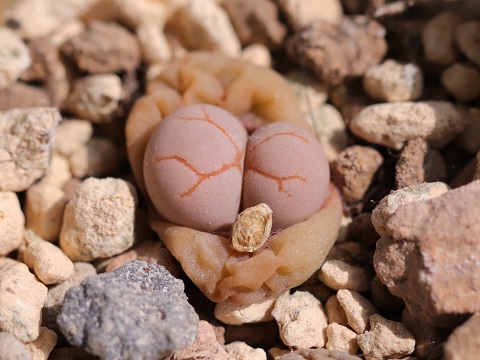
X3 photographs © Zhao Wenya.
This is a pattern-bred cultivar with branching, orange-brown lines on a pinkish or pale, rounded plant body. Markedly different seedlings were selected from seed obtained from plants purchased in 2018 that resembled L. werneri and ‘Sunflowers ZW’. ‘Hejian’ was established by Zhao Wenya in the M.S.G. Bulletin vol. 39, p. 2 (2024), where the small size and readily produced yellow flowers suggest L. werneri is one of the parent plants. The epithet meaning “located among rivers”, is tribute to the authors’ hometown of “Hejian”, which has a 3000-year history.
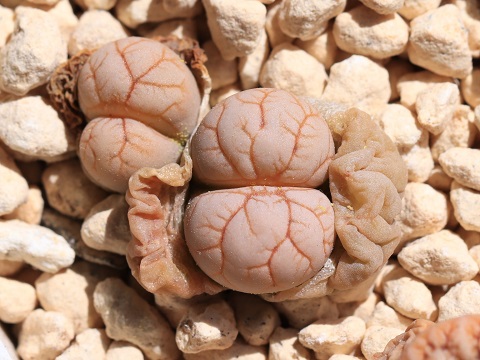
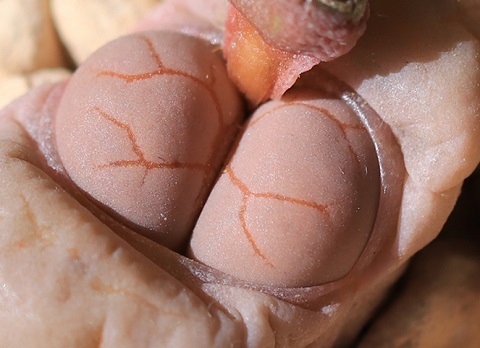
Lithops N.E.Br. julii (Dint. & Schwant.) N.E.Br. subsp. fulleri (N.E.Br.) B.Fearn var. fulleri ‘Fuyu Mountain SY’.
Lithops julii subsp. fulleri var. fulleri ‘Fuyu Mountain SY’. A light cream-green bodied cultivar with light gold margins and window patches interspersed with green flecks. Publication pending.
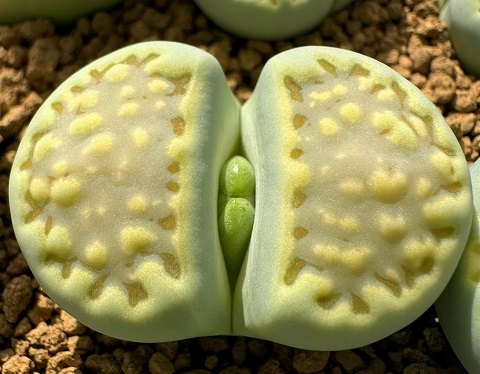
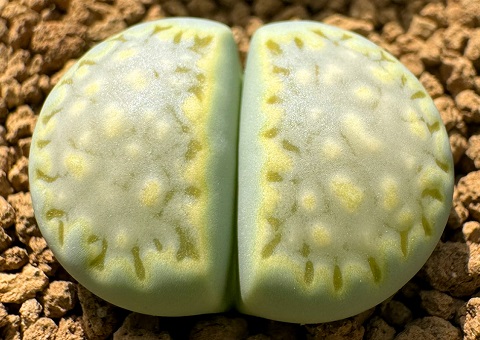
X3 photographs © Shi Yu.
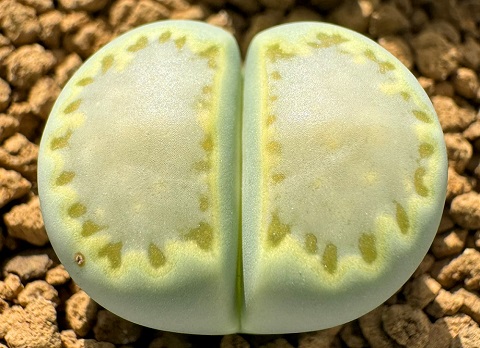
Lithops N.E.Br. julii (Dint. & Schwant.) N.E.Br. subsp. fulleri (N.E.Br.) B.Fearn ‘Lugu Lake’.
Lithops julii subsp. fulleri ‘Lugu Lake’. First published by Shao Yuan in “Lithops julii ssp. fulleri 'Lugu Lake', Mesemb Study Group Bulletin 40(3): 72. (August) 2025”. Image example: 5 photographs of plants accompanying the protologue, taken by Shao Yuan of China. A green cultivar with fully open, “smoggy” windows, no islands and a solid yellow marginal band.
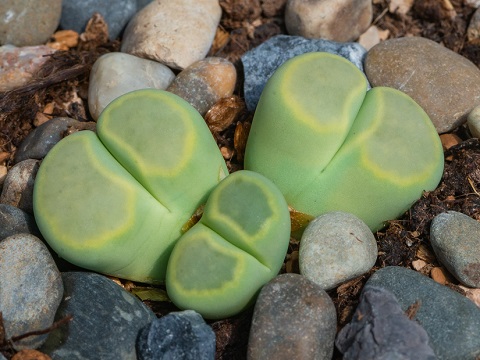
X4 photographs © Shao Yuan.
This is both a pattern-bred cultivar and a G- (type ‘acf’). Plants have open windows that are void of islands and a solid yellow marginal band. Although hybridization cannot be ruled out completely, specimens were raised from “unique individuals” of ex-C56A ‘Fullergreen’ stock noticed in 2015. Establishment was by Shi Yu in the M.S.G. Bulletin vol. 40, p. 72 (2025), where he described the windows as “smoggy”, sometimes “completely opaque”. The epithet celebrates Lugu Lake in China, where Shao Yuan and his wife first began their honeymoon. The flower colour is the standard white of the species.
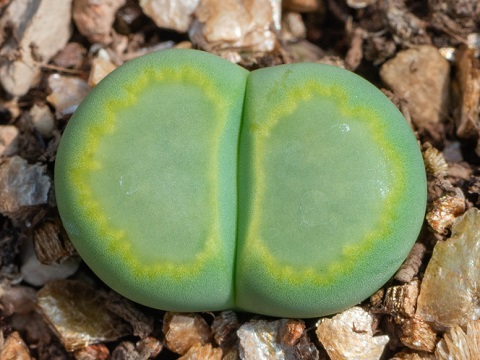
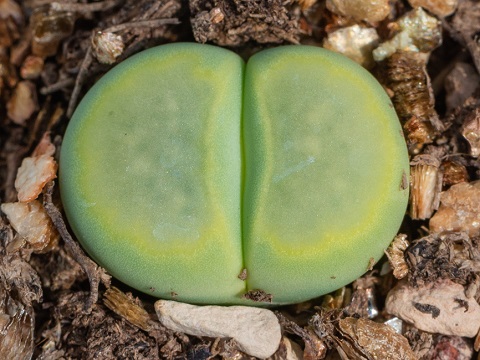
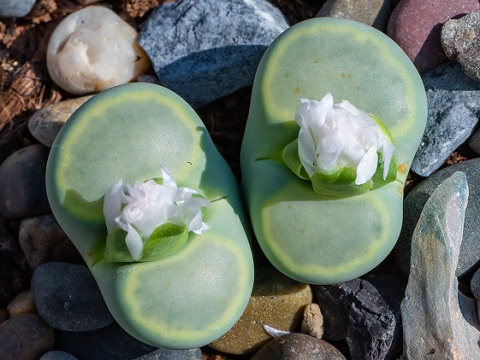
Lithops N.E.Br. karasmontana (Dint. & Schwant.) N.E.Br. subsp. eberlanzii (Dint. & Schwant.) D.T.Cole ‘Mirage’. (cultivar)
Lithops karasmontana subsp. eberlanziii ‘Mirage’. First published by Hu Haixi in “A stable ‘Mirage’, Mesemb Study Group Bulletin 40(1): 88. (February) 2025”. Image example: 5 photographs of plants accompanying the protologue, taken by Hu Haixi of China. A pink bodied cultivar with bold brown to red channels.
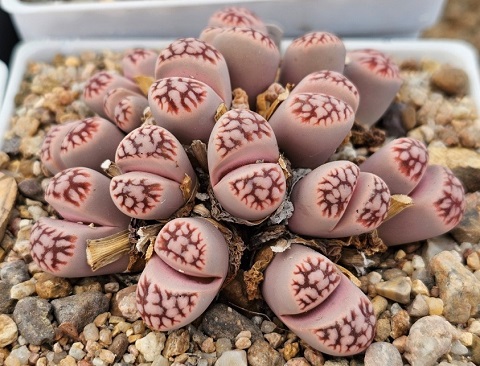
X3 photographs © Hu Haixi.
This is a pattern-bred cultivar with a pink or pinkish body and bold rubrications. The rubrications are mostly dark brown, but merge to red as they taper into the margins. Named by his wife, ‘Mirage’ was raised from ex-C39 seed and established by Hu Haixi in the M.S.G. Bulletin vol. 40, p. 16 (2025). Other than the striking facial colour and pattern, ‘Mirage’ is identical to normal subsp. eberlanzii and accordingly flowers white.
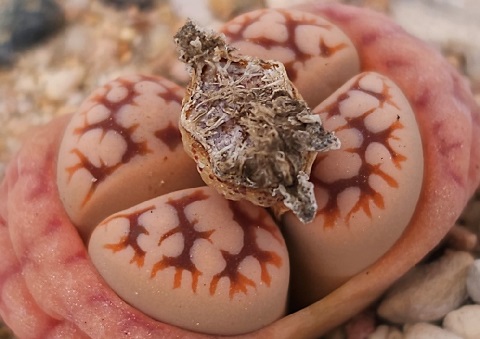
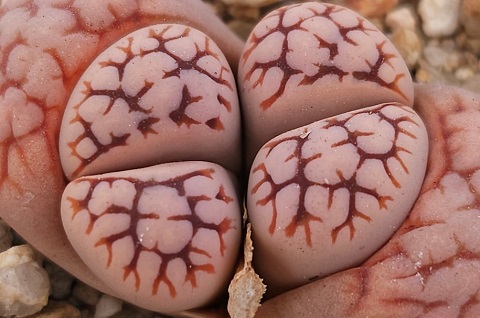
Lithops N.E.Br. karasmontana (Dint. & Schwant.) N.E.Br. ‘Suiren’. (cultivar)
Lithops karasmontana ‘Suiren’. First published by Zhang Shijia & Wei Zichu in “A New Pattern Cultivar: Lithops karasmontana ‘Suiren’, Mesemb Study Group Bulletin 38(3): 59-60. (December) 2023”. Image example: 2 photographs of plants accompanying the protologue, taken by Zhang Shijia & Wei Zichu of China. A cultivar with radiating red lines on a relatively smooth, yellowish face.
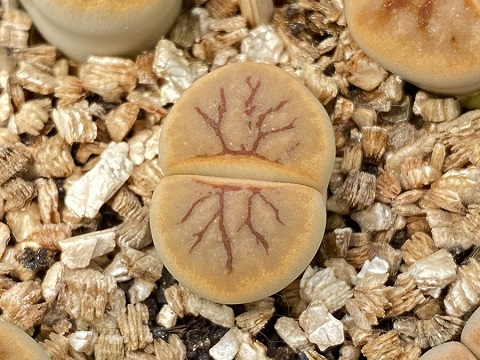
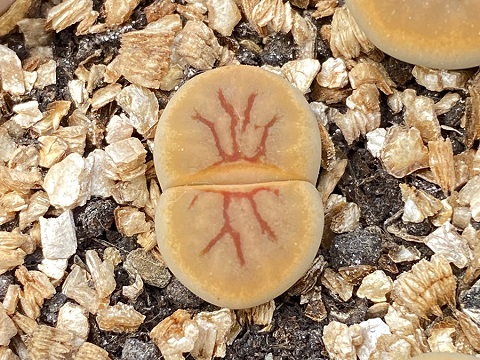
X4 photographs © Zhang Shijia & Wei Zichu.
This is a pattern-bred cultivar with radiating red lines on an “earthy” yellow-brown face. ‘Suiren’ was established by Zhang Shijia & Wei Zichu in the M.S.G. Bulletin vol. 38, pp. 59-60 (2023), where the relatively smooth facial texture was also highlighted. The radiating lines may either be concise or slightly blurred with somewhat diffuse ends near the outer facial margins. There is also a thin line of rubrication along the fissures. As the exact status of the originating plants remains uncertain, the cultivar epithet follows the species name. Plants are from the “L. karasmontana complex”, rather than being confirmed as subsp./var. karasmontana as misprinted in the establishment article. As with normal L. karasmontana the flower colour is white, and the cultivar epithet reflects an ancient Chinese tribal leader who taught fire raising.
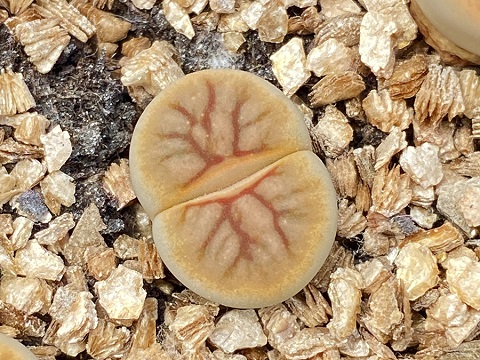
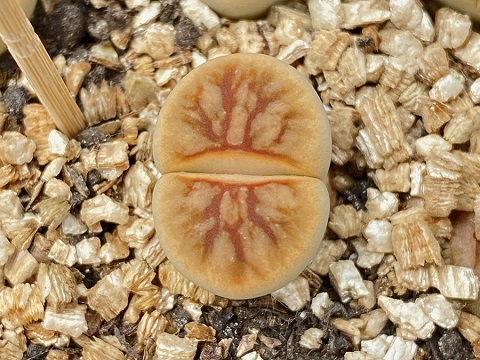
Lithops N.E.Br. naureeniae D.T.Cole ‘Pinkies’. (cultivar)
Lithops naureeniae ‘Pinkies’. First published by Steven Hammer in “Lithops naureeniae ‘Pinkies’, Mesemb Study Group Bulletin 40(1): 17. (February) 2025”, originating from Sebastian Lee of Connecticut, USA. Image Example: 2 photographs accompanying the protologue, taken by Carlos Morera of Los Angeles, USA, of plants in the collection of fellow American Steven Hammer. A pinkish-mauve bodied cultivar.
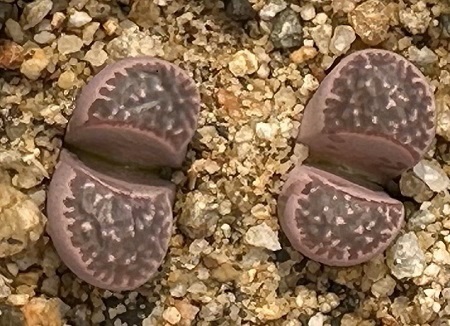
Pinkish-mauve specimens of L. naureeniae were raised by Sebastian Lee of Connecticut, USA, and presented to Steven Hammer. A photograph of those plants was subsequently taken by Carlos Monera, two versions of which were published in the M.S.G. Bulletin vol. 40, p. 17 (2025). Other than the deviant body colour, plants are identical to normal specimens.
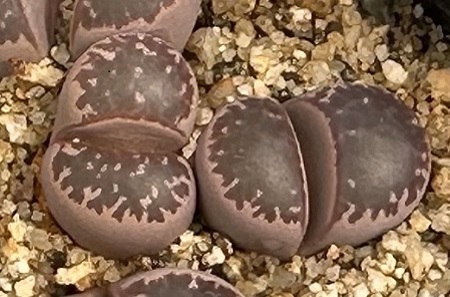
X3 photographs © Carlos Monera.
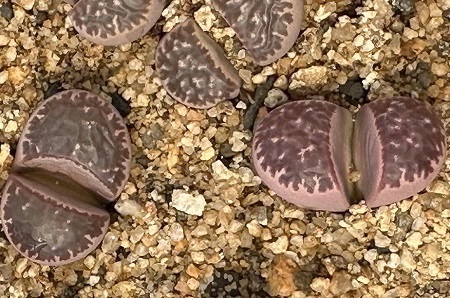
Lithops N.E.Br. naureeniae D.T.Cole ‘Hulun Buir’. (cultivar)
Lithops naureeniae ‘Hulun Buir’. First published by Shao Yuan in “Lithops naureeniae ‘Hulun Buir’, Mesemb Study Group Bulletin 38(4): 88. (April) 2024” (issue 4 of 2023). Image example: 3 photographs of plants accompanying the protologue, Figs 38.90–38.92 on page 89, taken by Shao Yuan of China. An intensely green cultivar with normal yellow, white-centred flowers.
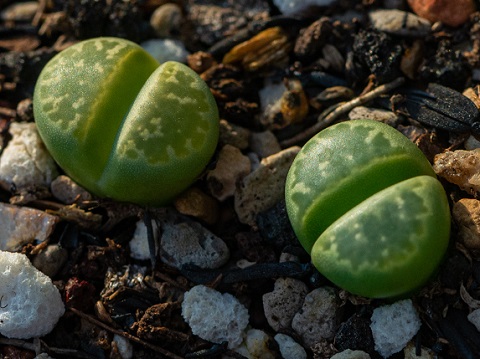
This is a G- (type ‘acf’) of Lithops naureeniae established by Shoa Yuan in the M.S.G. Bulletin vol. 38, p. 88 (2024). As explained there, the “plant bodies… have an intense green colour which sometimes is tinted yellow around the margins and islands. In shape and pattern however, they are similar to ordinary L. naureeniae and retain the yellow with white centre flowers” (to varying degrees). Whilst natural specimens may also exhibit shades of green, the colour here is much more vibrant and saturates the entire plant body. The epithet is tribute to the Hulunbuir Grassland of the Inner Mongolia Autonomous Region in China, a large area of verdant growth.
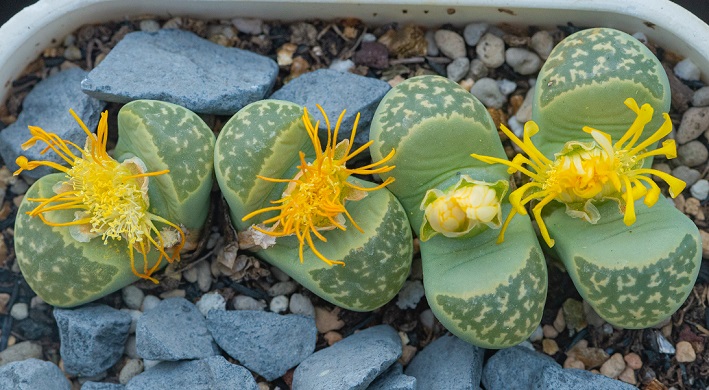
X3 photographs © Shao Yuan.
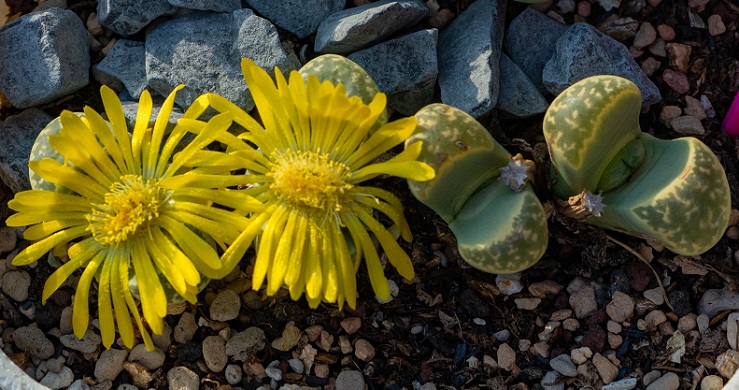
Lithops N.E.Br. pseudotruncatella (Berg.) N.E.Br. subsp. dendritica (Nel) D.T.Cole ‘Tok's Rock’. (cultivar)
Lithops pseudotruncatella subsp. dendritica ‘Tok's Rock’. First published by Boris Rommer in “Lithops 'Tok's Rock', Avonia 42 (1): 64-67. (March) 2024”, originating from Tok Schoeman of Namibia. Image example: Five photographs accompanying the protologue, figures 5-10 on pages 66-67, taken by Boris Rommer of Germany. A cultivar with enhanced red-brown, almost honeycomb patterned channels on a pale face.
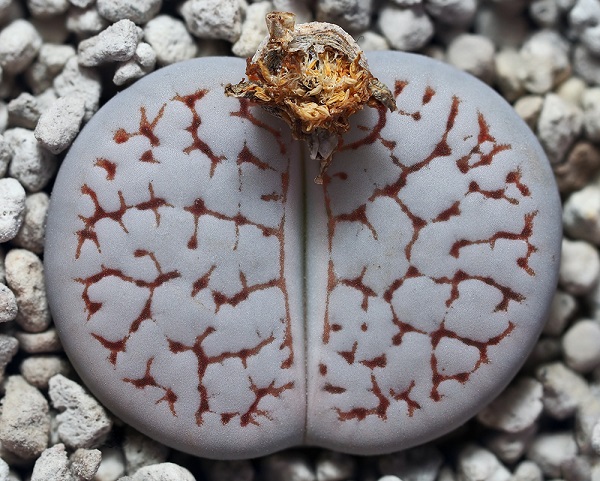
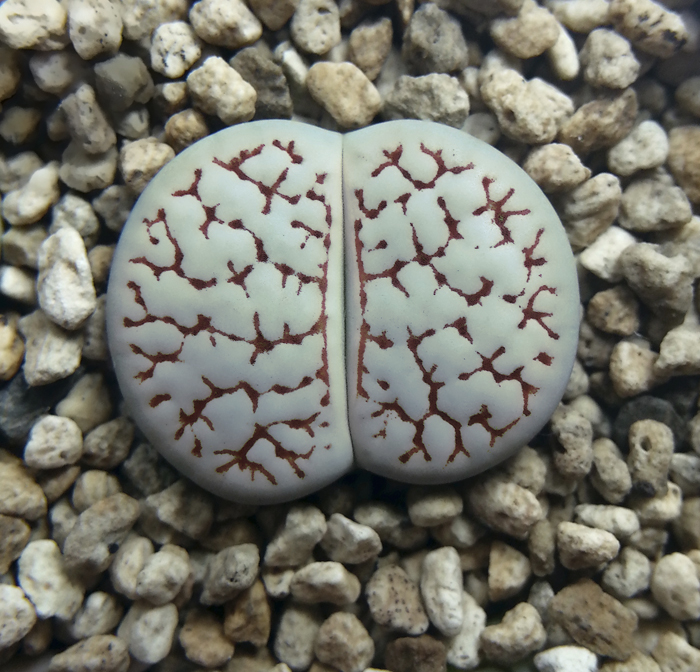
As in the published description, this is a pattern bred cultivar of L. pseudotruncatella subsp. dendritica with “strongly embossed channels that are mostly filled with red-brown rubrications and sometimes form an almost honeycomb pattern. In some ways the plants resemble the unpublished *pulmonuncula form depicted on p. 267 of Lithops-Flowering Stones 2005, but in ‘Tok’s Rock’ the red-brown pattern is even stronger and the contrast to the pale, blueish-grey face even greater.” The plants were bred by Boris Rommer of Germany, but originated from a strongly marked selection numbered TOK006A by the late Tok Schoeman of Namibia. Establishment in honour of Tok was by Boris in Avonia vol. 42, pp. 64-67 (2024), with photographs on pp. 66-67. Other than the striking facial pattern, plants are identical to normal subsp. dendritica.
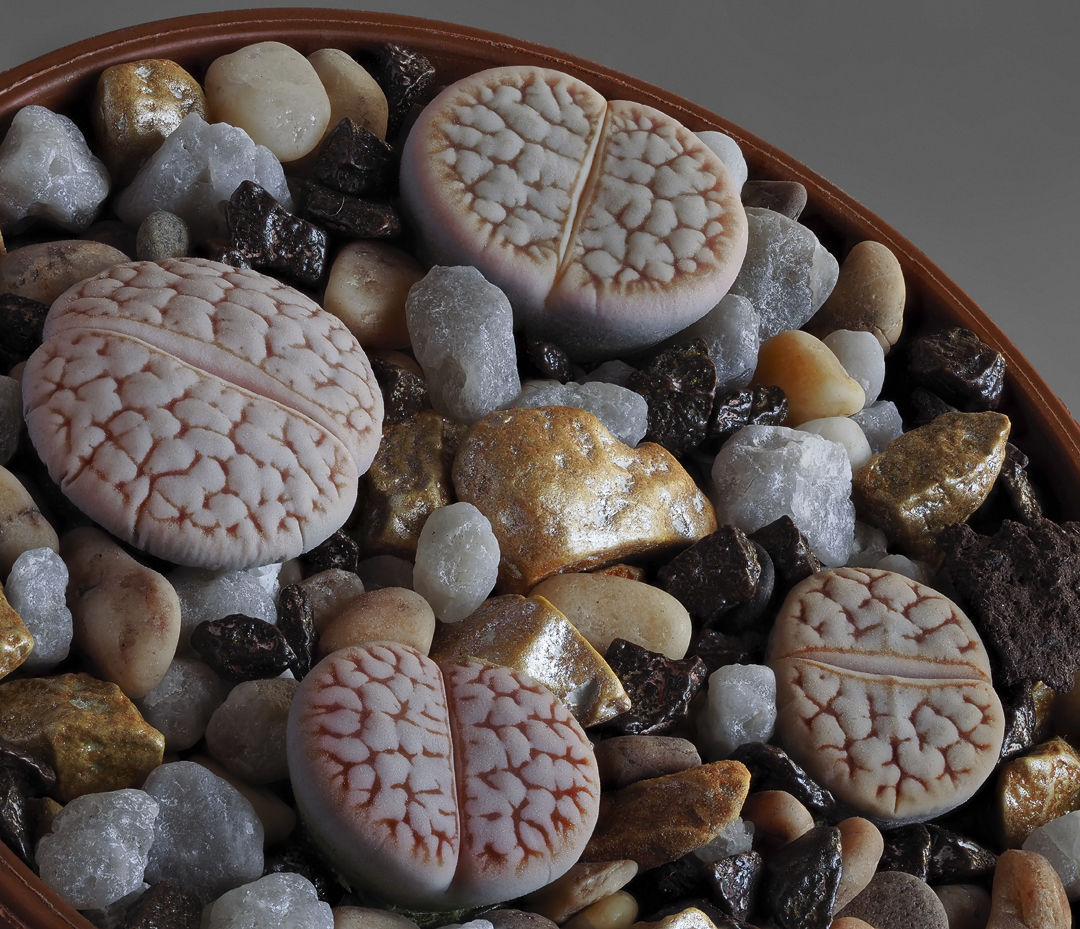
photographs X3 © Boris Rommer.
Lithops N.E.Br. schwantesii Dint. subsp. schwantesii var. marthae (Loesch & Dint.) D.T.Cole ‘Torra Red’. (cultivar)
Lithops schwantesii subsp. schwantesii var. marthae ‘Torra Red’. First published by Hilde Mouton & Roy Earlé in “The tale of a little red stone, Cactus World 41(1): 65-66. (March) 2023”. Image example: 5 photographs of plants accompanying the protologue, taken by Hilde Mouton & Roy Earlé of Namibia. A dark red or maroon bodied cultivar of var. marthae. “Torra” is a term used in Namibia for a stone or rock.
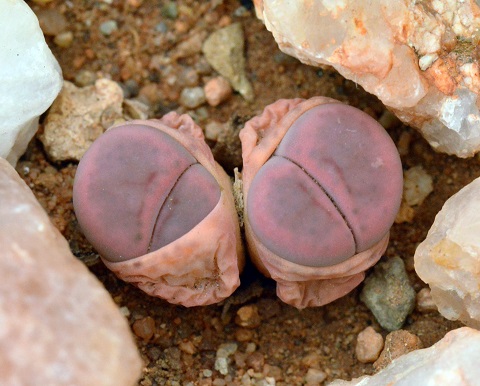
photograph © Hilde Mouton & Roy Earlẻ.
This is a “dark red to maroon” cultivar developed from a single habitat collected C411 mutant head (on an otherwise normal plant) by Professor Cole, and seed obtained from a nearby colony by Tok Schoeman. Selective breeding by Hilde Mouton and Roy Earlé followed when both the Cole and Schoeman collections were rehoused at the Alte Kalkӧfen Lodge in Namibia. This R- (type ‘acf’) was established by Hilde and Roy in Cactus World vol. 41, pp. 65-66 (2023), where occasional “red petal tips” on the otherwise normal yellow flowers and “dusky dots being only a few or more often absent” were mentioned. Generally plants have fewer rubrications and less distinct margins than the otherwise similar var. schwantesii ‘Purple Haze’.
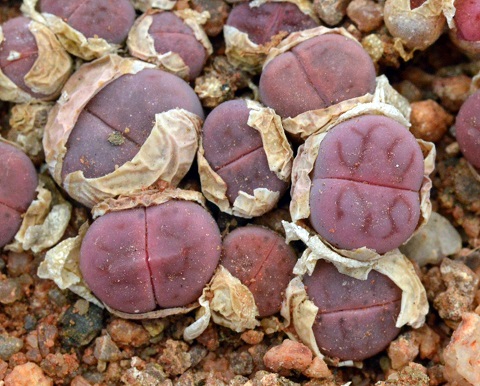
photograph © Hilde Mouton & Roy Earlẻ.
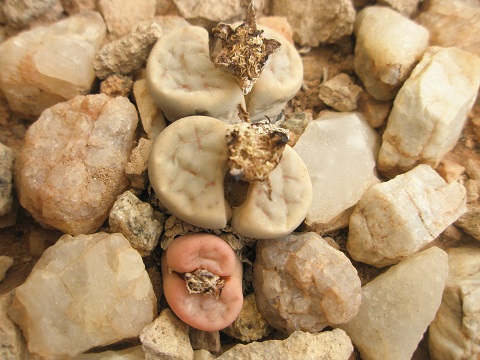
photographed by the author in 2009.
Lithops N.E.Br. vallis-mariae (Dint. & Schwant.) N.E.Br. ‘Orange Peel’.
Lithops vallis-mariae ‘Orange Peel’. First published by Eric Collins in “Lithops: A new pattern bred cultivar, Capital Cactus, (October 2024 [Online]). Available at: www.cactusact.org.au, with 2 hard copies lodged at the Lindley Library, 80 Vincent Square, London, SW1P 2PE, on 25-07-2025”. Image example: 4 photographs of plants accompanying the protologue, Figs 1–4, taken by Eric Collins of Snowtown, Australia. A cultivar with orange tinted faces and plant bodies.
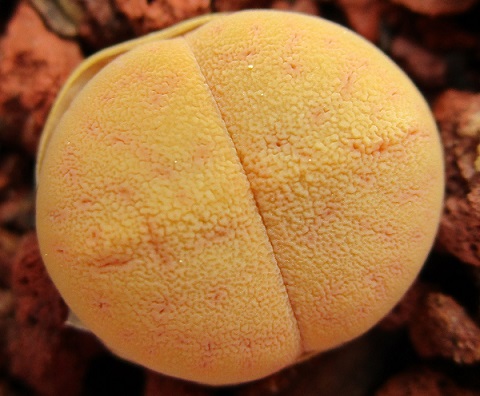
X3 photographs © Eric Collins.
This is a pattern-bred cultivar with orange-tinged faces and plant bodies. To varying degrees and either with or without reddish-brownish facial flecks, the tiny surface wrinkles so typical of this species make it resemble orange rind. Plants from ex-C166 & ex-C167 were selected and raised over several years by Eric Collins of Snowtown, Australia, and established by him electronically in Capital Cactus, the on-line journal of the Cactus & Succulent Society of the ACT Inc. (2024), with 2 hard copies lodged at the Lindley Library in London on 25-07-2025. Other than the lovely orange colour of the plant bodies and faces, specimens are identical to normal L. vallis-mariae and accordingly flower yellow.
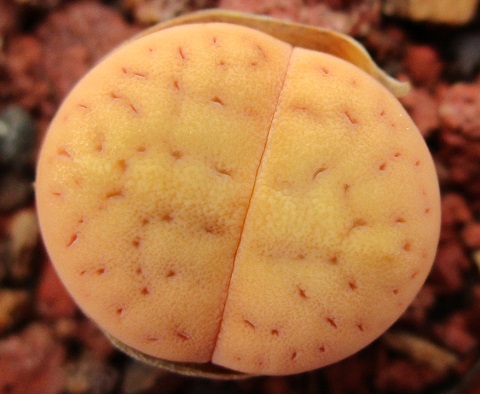
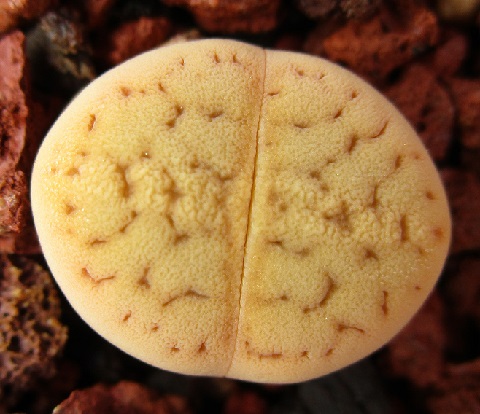
Brickell, C.D., Alexander, C, Cubey, J.J., David, J.C., Hoffman, M.H.A., Leslie, A.C., Malécot, V., Xiaobai Jin. (2016), International Code of Nomenclature for Cultivated Plants Ninth Edn. Leuven: International Society for Horticultural Science.
Cole, D.T. (1988) Lithops Flowering Stones. Randburg: Acorn Books.
Cole, D.T. & Cole, N.A. (2005) Lithops Flowering Stones. Milano: Cactus & Co.
Collins, E. (2024) ‘Lithops: A new pattern bred cultivar’, Capital Cactus, October [Online]. Available at: www.cactusact.org.au (Accessed: 14 October 2024).
Green, K. (2023) ‘Whistle-stop Lithops’, Dinteranthus, 35 (2), pp. 28-35.
Green, K. (2024) ‘THAT ONE'S GREEN’, Mesemb Study Group Bulletin, 39 (1), p. 2.
Green, K. (2025) ‘Lithops 'Green Kiku'’, Mesemb Study Group Bulletin, 40 (1), p. 17.
Haixi, H. (2025) ‘A stable ‘Mirage’’, Mesemb Study Group Bulletin, 40 (1), p. 16.
Hammer, S. (2025) ‘Lithops naureeniae ‘Pinkies’’, Mesemb Study Group Bulletin, 40 (1), p. 17.
JaeWoon, K. (2023) ‘A CUP CAKE CULTIVAR’, Mesemb Study Group Bulletin, 38 (3), pp. 59-60.
Mouton, H. & Earlé, R. (2023) ‘The tale of a little red stone’, Cactus World, 37 (1), pp. 30-50.
Mouton, H. & Mouton, F. (2024) '‘FEDERVOGEL GREEN’ A NEW LITHOPS CULTIVAR', Mesemb Study Group Bulletin, 38 (4), p. 88.
Rommer, B. (2024) ‘LITHOPS 'TOK’S ROCK’', Avonia, 42 (1), pp. 64-67.
Shijia, Z. & Zichu, W. (2023) ‘A NEW PATTERN CULTIVAR: LITHOPS KARASMONTANA ‘SUIREN’’, Mesemb. Study Group Bulletin, 38 (3), pp. 59-60.
Wenya, Z. (2024) ‘LITHOPS 'Hejian'’, Mesemb Study Group Bulletin, 39 (1), p. 2.
Yuan, S. (2024) ‘LITHOPS NAUREENIAE ‘HULUN BUIR’’, Mesemb Study Group Bulletin, 38 (4), p. 88.
Yuan, S. (2025) ‘LITHOPS JULII SSP. FULLERI ‘LUGU LAKE’’, Mesemb Study Group Bulletin, 40 (3), p. 72.
Using the Cole research material for guidance, this Lithops Scrapbook IV project will be updated as appropriate.

